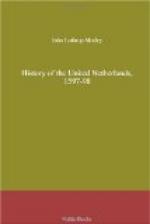Maurice lost no time in plunging with his whole mounted force through the watery defile; directing the infantry to follow as fast as practicable. When the commander-in-chief with his eight hundred horsemen, Englishmen, Zeelanders, Hollanders, and Germans, came upon the heath, the position and purpose of the enemy were plainly visible. He was not drawn up in battle order, waiting to sweep down upon his rash assailants so soon as, after struggling through the difficult pass, they should be delivered into his hands. On the contrary, it was obvious at a glance that his object was still to escape. The heath of Tiel, on which Spaniards, Italians, Walloons, Germans, Dutchmen, English; Scotch, and Irishmen now all found themselves together, was a ridgy, spongy expanse of country, bordered on one side by the swollen river, here flowing again through steeper banks which were overgrown with alders and pollard willows. Along the left of the Spanish army, as they moved in the direction of Herenthals, was a continuous fringe of scrub-oaks, intermixed with tall beeches, skirting the heath, and forming a leafless but almost impervious screen for the movements of small detachments of troops. Quite at the termination of the open apace, these thickets becoming closely crowded, overhung another extremely narrow passage, which formed the only outlet from the plain. Thus the heath of Tiel, upon that winter’s morning, had but a single entrance and a single exit, each very dangerous or very fortunate for those capable of taking or neglecting the advantages offered by the position.
The whole force of Varax, at least five thousand strong, was advancing in close marching order towards the narrow passage by which only they could emerge from the heath. Should they reach this point in time, and thus effect their escape, it would be useless to attempt to follow them, for, as was the case with the first defile, it was not possible for two abreast to go through, while beyond was a swampy-country in which military operations were impossible. Yet there remained less than half a league’s space for the retreating soldiers to traverse, while not a single foot-soldier Of Maurice’s army had thus far made his appearance on the heath. All were still wallowing and struggling, single file, in the marshy entrance, through which only the cavalry had forced their way. Here was a dilemma. Should Maurice look calmly on while the enemy, whom he had made so painful a forced march to meet, moved off out of reach before his eyes? Yet certainly this was no slight triumph in itself. There sat the stadholder on his horse at the head of eight hundred carabineers, and there marched four of Philip’s best infantry regiments, garnished with some of his most renowned cavalry squadrons, anxious not to seek but to avoid a combat. First came the Germans of Count Sultz, the musketeers in front, and the spearsmen, of which the bulk of this and of all the regiments was composed, marching in closely serried squares, with the company standards waving over each. Next, arranged in the same manner, came the Walloon regiments of Hachicourt and of La Barlotte. Fourth and last came the famous Neapolitans of Marquis Trevico. The cavalry squadrons rode on the left of the infantry, and were commanded by Nicolas Basta, a man who had been trampling upon the Netherlanders ever since the days of Alva, with whom he had first come to the country.




